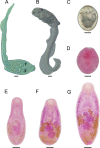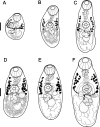Morphological, molecular, and life cycle study of a new species of Oligogonotylus Watson, 1976 (Digenea, Cryptogonimidae) from Colombia
- PMID: 36761075
- PMCID: PMC9848881
- DOI: 10.3897/zookeys.1115.75538
Morphological, molecular, and life cycle study of a new species of Oligogonotylus Watson, 1976 (Digenea, Cryptogonimidae) from Colombia
Abstract
The present study describes Oligogonotylusandinus sp. nov. and its life cycle from a rural fish farm in Sopetrán, Antioquia, Colombia. The endemic species of snail Aroapyrguscolombiensis and the fishes Poeciliacaucana and Andinoacaralatifrons are identified as the first intermediate host, the second intermediate host and the definitive host, respectively. The new species was defined through an integrative approach, combining the traditional morphology of its developmental stages with molecular analyses of the markers ITS2 from ribosomal DNA and COI from mitochondrial DNA. This new species can be distinguished from its congeners by genetic divergence, the position of the vitelline fields, and the number of gonotyls. This work represents the first report of a species of this genus in South America.
Keywords: Blue mojarra; Cauca molly; Oligogonotylus; South America; Trematoda; taxonomy.
Verónica Vélez-Sampedro, Mónica Uruburu, Carolina Lenis.
Figures







References
-
- Anucherngchai S, Tejangkura T, Chontananarth T. (2016) Epidemiological situation and molecular identification of cercarial stage in freshwater snails in Chao-Phraya Basin, Central Thailand. Asian Pacific Journal of Tropical Biomedicine 6(6): 539–545. 10.1016/j.apjtb.2016.01.015 - DOI
-
- Bray RA, Gibson DI, Jones A [Eds] (2008) Keys to the Trematoda, Volume 3. CAB International and Natural History Museum, London, 824 pp. 10.1079/9780851995885.0000 - DOI
-
- Castellanos-Morales CA, Marino-Zamudio LL, Guerrero-V L, Maldonado-Ocampo JA. (2011) Peces del departamento de Santander, Colombia. Revista de la Academia Colombiana de Ciencias Exactas, Físicas y Naturales 35: 189–212.
LinkOut - more resources
Full Text Sources
Research Materials
